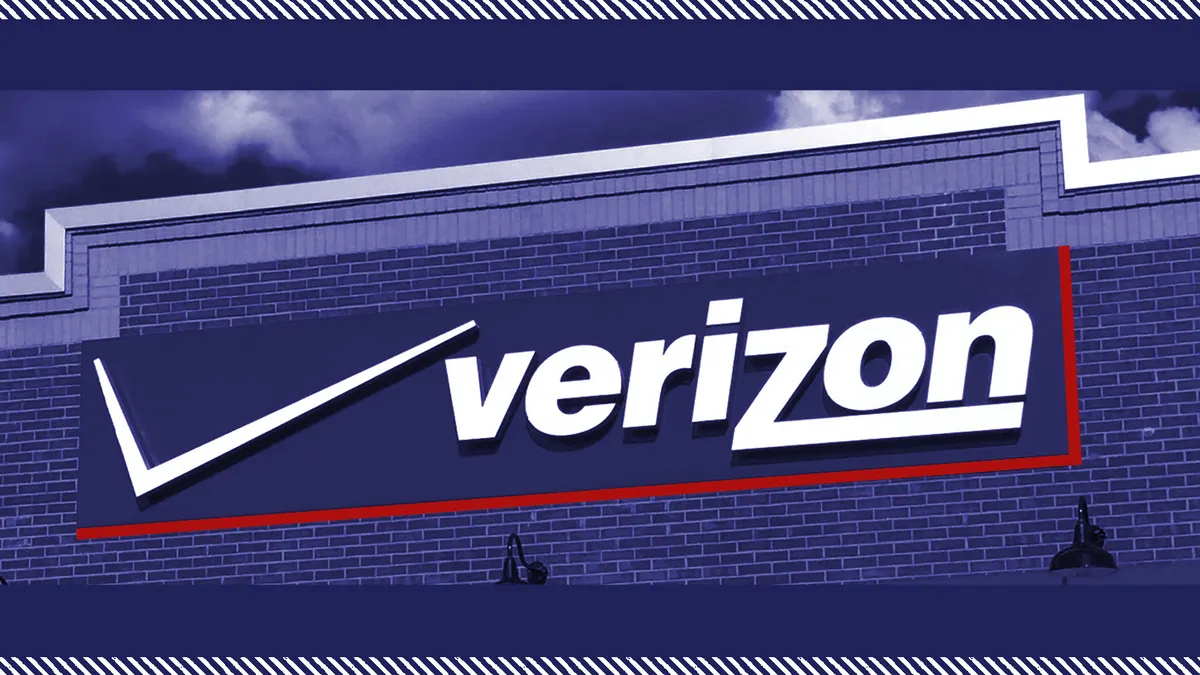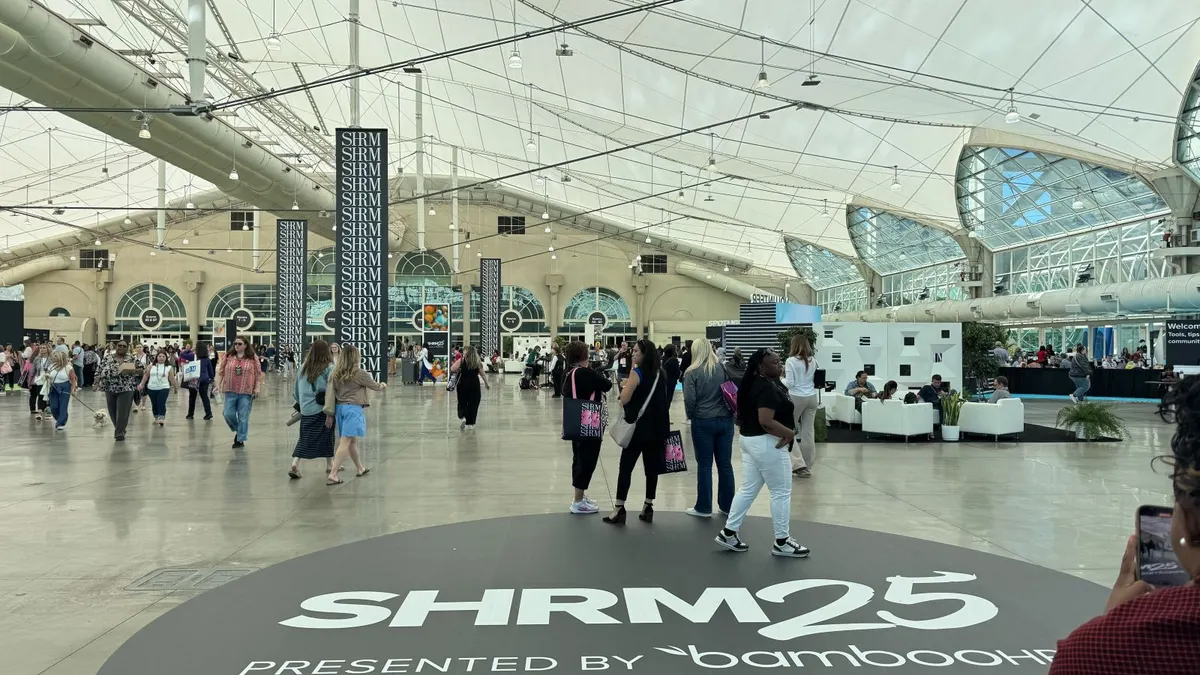Editor’s note: In the first installment of this series about major corporations’ response to the COVID-19 pandemic, HR Dive goes inside the crisis room with two senior leaders from Verizon that managed the response for a workforce of 135,000 people.
Like many multinational companies, Verizon has teams across the globe that handle business continuity issues. Its preparation is mostly for weather catastrophes and only sometimes for disease or other external disruptions. And normally these circumstances impact workers in a couple of offices or a single region. What has made the novel coronavirus outbreak so unique is that for most companies, every single employee is affected.
"This is a very different crisis than we typically manage," Joe Russo, Verizon’s senior vice president of operations, told HR Dive. "We typically have a very big focus on connectivity and restoring the network," he added, given that the vast majority of issues stem from weather. "But this is much more about people, and it's about their health."
For the leadership team at Verizon, that meant shepherding 135,000 individuals through a global pandemic while also maintaining the company’s critical communications services for more than 100 million customers. The company simultaneously saw a 25% increase in voice usage and moved nearly 90% of that workforce remote within 10 days, according to Christy Pambianchi, Verizon’s chief human resource officer.
"The fact that the infrastructure is being overwhelmed in many parts of the world is making this a real challenge," Pambianchi told HR Dive. "If you talked to me [earlier], we still were thinking that maybe only 30% of our jobs could be shifted [to] home. But we took ourselves to task around March 10, and said, 'we're going to need to move at speed to get everybody to work at home.'"
Verizon first announced March 12 that it would be shifting to fully remote work. Within a week, 70% of its employees were working remotely and that number grew to nearly 90% by the following week.
"We're really taking dramatic steps to say even if this work wasn't previously done at home, and we had a roadmap to figure out over the next five years how to do it, we've just enabled it in 72 hours," Pambianchi said.
This required significant changes for a workforce that includes retail stores, manufacturing facilities, call centers and technical repair teams, in addition to corporate offices.
"It's not pretty, and everything's not working perfectly, but we put employee safety and health very high on our priority list," Pambianchi shared, adding that keeping the company’s networks up and running was also of critical importance.
Russo and Pambianchi both said they were thankful the company had structures and procedures in place in preparation for a crisis, even though this one required a unique set of measures across the organization.
"It definitely built some new muscles that we didn't have before," Russo said, especially because this crisis management effort was so focused on the company’s people. "How do you continue to run to the crisis of our customers’ needs," Russo explained, while "balancing and really prioritizing the health and safety of our employees?"
On the radar
Verizon tracked the virus from the beginning of this year, after the spread reached critical mass in China.
"This crisis event started back in January, when we started to see the cases rise in Asia-Pacific," Russo said. "We implemented our business continuity plans in that area and stood up our regional crisis management team in APAC," or Asia-Pacific.
Verizon took the threat seriously, but it didn't predict how quickly COVID-19 would spread across the world. The U.S. Centers for Disease Control and Prevention (CDC) issued a travel advisory to Wuhan on Jan. 11. The first confirmed cases outside of China began to appear later that week.
"When they say [they are] 'shutting down Wuhan,' they've shut down Wuhan," Pambianchi said, recalling her experience working in China. "They have the capability to close off the city, or to close off an entire part of the country, and I think maybe we were all overly optimistic that it was being contained."
On January 21, the U.S. had its first lab-confirmed case. By the end of January, more than 20 countries had confirmed cases, events in Asia were being canceled and U.S. Secretary of Health and Human Services Alex Azar had declared a public health emergency. Verizon began standing up teams in the APAC and Europe, Middle East and Africa (EMEA) regions.
"We have regional crisis management teams, pre-identified resources from across the business, HR supply chain operations, legal labor, etc.," Russo said. "We have site emergency action plans, which typically are invoked when you have a problem at a site. It could be a storm that blows in, a hurricane, but you still can rely on those people."
In February, the CDC issued guidance that organizations should begin cutting travel and planning for remote work. It also warned that certain industries, such as airlines and healthcare, faced higher risk than others. During this time, Verizon activated its EMEA crisis response teams as the disease spread.
"When we saw it go to Switzerland, we realized this is not a regional issue, this is going to go global," Pambianchi said, adding that after the first U.S. case, "it was really clear that we didn't really know how it transmitted. But it was obvious that it transmitted human to human. And we started to begin to prepare for a pretty big outbreak across Europe and in the United States."
The virus continued to spread across the U.S., canceling major sporting events, concerts, business conferences and other events while the government deliberated over shelter-in-place orders and financial support for the businesses and people impacted.
"[COVID-19] is spreading in ways that we don’t fully understand," Pambianchi said. "I think that made it very difficult for the world to decide how aggressively should it act. ... I think the two months of debate about that, that occurred since it broke out in Wuhan, delayed certain response mechanisms around the world."
Having already responded to the pandemic in two global regions, Verizon was ready for the U.S. spread, though it would impact far more employees once it hit stateside.
"I think one of the things that really helped us was getting our regional teams stood up in APAC, and then in EMEA," Russo said. "We used their experience, even though it was only a couple weeks old, to really define our playbooks here in the United States.
Activating response teams
As the virus spread across the world, Pambianchi activated new processes for her HR teams to better support employees. Employees and HR business partners can submit questions or concerns through an employee portal.
"We put an HR command center up right away ... after this broke in Switzerland and Seattle," she said. "It was evident there were going to be so many nuances that, rather than trying to make up a set of policies and distribute them for everybody to try to implement, we've left the field as the intake and then I have a command center of HR folks that man the lines and take HRBP calls all day so that we could be giving consistent answers to all of the employee circumstances that will come up."
While this pandemic altered work at an unprecedented scale, Verizon’s business continuity teams were prepared to activate. Those teams report to Russo, who worked closely with Pambianchi, representing the interests of the business unit leaders that report directly to the CEO. The two were part of a core team that held a conference call every morning, before they determined how to communicate changes and other messaging across the organization.
"Joe and I are on an open bridge all day long," Pambianchi said. "At any given time, we can activate and pull the right people in so we could get decisions escalated and made quickly."
They needed to make some additions to the impromptu task force given the widespread people-management needs of the current situation. This included members of the company’s health and safety teams, whom Russo said were "normally tangential" to business continuity efforts.
"They're the ones who typically are not only working with the CDC and other state local agencies, but they're also talking with other companies to learn and share best practices around what they're seeing and how they're dealing with the situation. … it became very apparent that they had to have a full seat at the table at every meeting in this particular event."
Normally, every business unit leader would not need to be part of these conversations, but they helped raise critical issues to leadership and communicate any changes to the workforce. Verizon quickly put up a public resource center to free itself from network access barriers where it delivered video updates to employees every day at noon.
"We felt [it was] really important for people to see our leaders, hear from us what's happening. I think in times of uncertainty, there's so much misinformation and people are really scared," Pambianchi said.
It was also important to involve the business unit leaders so they didn’t scramble to create their own solutions without any central company support. Pambianchi checked in with those leaders daily, "so they know if they have issues, they're not deciding and cowboy-ing in the field. … they know they’ve got a call with us once a day, we update our policies, then we go."
Ultimately, the crisis response infrastructure stretched across the company through business continuity, HR and the lines of business.
"There's the front line of our business continuity all the way to the CEO plumbed every day, and yet we reach out horizontally and find out from all the leaders what's going on on the frontline of their business, so that they know they're going to get answers, in real time to the issues that they're facing."
Addressing employee concerns and creating a variety of channels for them to be aired was also a key part of Pambianchi and Russo’s plan.
"Part of our playbook is to make sure that we have good communication channels," Russo said. "That we're making any policy decisions quickly and communicating those so that our employees just have peace of mind that their financials will be cared for, that their families will be cared for, that their health will be cared for."
In response to these employee concerns, and others raised through various channels, Verizon asked employees to stay home if they were feeling sick, facilitated quarantining as needed and reassured workers that they would be paid.
"We've got pay protection for folks in basically any circumstance that can happen as a result of this," Pambianchi said. The company also recently launched a caregiver benefit.
Extreme measures, extremely fast
One group whose work was impacted significantly within Verizon was the field technicians, who work primarily out of vans to install and repair cable and internet systems for customers. Pambianchi estimated there are 90,000 employees who are in either this role, customer service or working at retail stores. All of these jobs required significant upheaval as the shift to remote work began.
"We had a situation where inside of 24 hours we had a location with 1,000 people that we needed to close," Pambianchi shared, emphasizing how fast and widespread the copmany's response needed to be. "We had an asset pickup day, we cleaned all the assets and then told everybody to come to work, we'll come out to your car and give you a computer and things that you need to work from home. We just would not have thought that was possible even a week ago."
In retail stores, Verizon supported "critical needs" only. It also changed operating hours, implemented a "pick-up only policy" and directed consumers to online services, as Pambianchi wrote on LinkedIn.
For field technicians, the move was even more drastic. Their day-to-day normally involves working out of a central office which holds equipment, and then driving out in vans or trucks with enough supplies to service the day’s clients. Now, they’re "garaging" from home, where they store enough equipment to last them at least a week. They’re also mostly only answering emergency calls.
"We do have a backlog of customer calls and entries that would require entry to the home that we feel is something that's not mission critical," Pambianchi said. "If a home is connected, we can check that the home is connected. That's what we're focusing on."
In terms of making changes and updates to company policies and procedures, Pambianchi said there is a two-hour turnaround for making decisions once new guidance comes in from the CDC.
"[There are] new processes and playbooks we've had to put in place to respond to all of the CDC guidance around social distancing, around cleaning, around closing of facilities around tracking of people and who they potentially came in close proximity with, so that we quarantine appropriate groups," Russo said.
Lessons learned
At this point, Pambianchi said she believes there is an opportunity to pivot to a "new normal" after "four pretty unsettling weeks."
She and Russo place a lot of value in the pre-existing business continuity structure in place and the new ones made to help the company navigate the global pandemic. "[We had] a cross business leader group, our executive steering committee, and then our strategic crisis leadership team," Russo said.
Russo recommended other employers set up and rely on "that structure and the predefined communication plans on how [to] manage a crisis," adding that, "having those in place, practicing those things served to be invaluable for Verizon."
As a global provider of an essential service, Verizon also had to make sure it had the capacity to continue services for tens of millions of customers.
"We're trying to keep running the company, too," Pambianchi said. "So we're also mindful that everything can't stop. We're running Verizon. So, we've been responding to the crisis and then also responding to how ... we keep all of the other things going that are important to deploying 5G and bringing that capability on. So it's a balance"
After surviving the initial tumult, Verizon is now looking ahead to optimize its mostly remote workforce and monitor for signs that it can resume some normal business activity.
"We're trying to get people more productive at home and make sure that they're more stable," Russo said. "But what we're really shifting to now is that idea of, assume we start to hit a plateau, assume that we start to see the cases drop, that we can start sometime in the future, getting back to [a] less-crisis mode."
Russo said he thinks the United States is "several weeks away" from returning to offices and resuming some normal forms of work, but that domestic businesses will have a chance to see what that looks like now in Asia, where the threat is dissipating, and in Europe in the near future.
"I would encourage any company to really be looking at what's happening in Europe right now as almost a week-and-a-half to a two-week predictor of what I think the United States is headed towards, in the next couple of weeks," Russo said. "So far that’s largely held true."





















